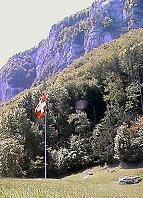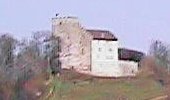History of Switzerland
(1291-1515)
The official date of birth of the Old Swiss Confederation
is August, 1st 1291. This date can be found on a document
of alliance whose age of more than 700 years has been confirmed by
radionuclear (C14) analysis recently. It all began with a
new transalpine trading route and with three small valleys in central
Switzerland that had remained outside the focus of the dukes and kings
for a long time.
Serious historians will always separate the facts of history
from the popular legends concerning the origins of the old
Swiss confederation.
The trade route over St. Gotthard pass
From the 11th to the 13th centuries, many
cities (among them the federal capital Berne, Lucerne, and Fribourg)
were founded. Skilled craftsmen specialized in producing high quality
goods and trade became more important in a society in which farmers
had used to be self-suppliers for centuries. Trade gave also more
importance to roads crossing the Alps, a mountain chain with peaks of
up to 4000 m (12000 ft) separating central Europe from Italy and
the Mediterranean Sea.
At the same time, people from the upper part of Wallis (Rhone valley)
developed means to suspend wooden water pipes and catwalks in steep
rocks. Some of these people from Wallis wandered east and settled in
upper Uri and Graubünden [Grisons] around A.D. 1200.
So the Schöllenen canyon in Uri, that had blocked the way
from Lake Lucerne to St. Gotthard pass, was overcome by the new
technology and a new trade route developed. |
|
![Alpine road of St. Gotthard: Teufelsbrücke [devil's bridge] over Schöllenen canyon](picture/schollenen-devils-bridge.jpg)
Devil's Bridge over Schöllenen canyon.
The lower bridge on the picture shown here is more than
hundred years old, but does of course not date back to the 13th
century. It may give an impression of the steep canyon that had to be
overcome by suspended catwalks, however. |
Liberation: Federal Pact and the Rütli
The new trade route made those regions far from the centers of power
look interesting for the counts of Habsburg (northern
Switzerland) who were trying at the time to strengthen their dynastic
power. As a reward for help in several war expeditions to Italy, German
king Friedrich II exempted the valleys of Uri (1231) and Schwyz (1240)
from the jurisdiction of any counts and dukes so they would be subject
to the king alone.

Rütli |
|
When his successor king Rudolf of Habsburg,
the first German Emperor from this house, died in 1291, people from
Uri, Schwyz and Unterwalden feared that the counts of Habsburg
would try to regain influence in their territories. So they swore to
help each other against anyone attempting to subject them. This is the
historical background of the legend of the Oath on Rütli
(a meadow on the western shore of Lake Lucerne, see picture). While the
Federal Charter
(Bundesbrief), dated from "the first days of August, 1291"
is a historical fact and can be seen at the
Museum of the federal charters in Schwyz
[during summer of 2006, the federal charter has been on
exhibition in the USA for a few weeks],
the Oath on Rutli is a legend (anyway well composed,
because of the secret nature of the beginning of the history of the
old Swiss confederacy). Towards the end of the 19th century,
August 1st was introduced as a national holiday. |
Another popular legend tells of
Wilhelm (William) Tell,
the Swiss national hero of liberty. There is, however, no historical
evidence that he ever may have lived, shot an apple from his son's
head and killed a tyrannic bailiff with his crossbow as the legend tells.
Not even his name (or any similar name) is mentioned on any
known document from this time. |
|
 |
Only nearly 200 years later, when the
Swiss confederacy had already grown and was well established,
the legend appears in a chronicle named the White Book of Sarnen
(written in 1470) and in a ballad praising Switzerland's success
against the duke Charles of Burgundy (1476/77). While historian
Jean François Bergier
is inclined to believe, that the legend is based at least partially on
historic events, many others
refuse to accept this legend alltogether. But no doubt,
the legend itself has become a historical factor that has influenced the
history of Switzerland between 1500 and
1945
as well as of other countries (France, Germany) quite a lot.
The battles of Morgarten, Sempach and Näfels
The counts of Habsburg tried to reach their goals by military
force but were defeated several times (battles of Morgarten 1315,
Sempach 1386, Näfels 1388) and finally even had to leave
their native castle in northern Switzerland, while they were on the
other hand strong enough to gain the German crown from their new seat
in Austria, where their dynasty remained in power until 1918.
Lucerne entered into the confederacy in 1332, Zürich
in 1351, Zug in 1352, Berne and Glarus in 1353.
Appenzell signed an alliance as associated member in 1411,
the city of St. Gall in 1412 (both of them against the
dominance of the monastery of St. Gall in the region). Uri,
Unterwalden and Lucerne allied with the bishop of Sion (VS)
and the inhabitants of the upper Rhone valley in 1403.
When the lords of Raron (VS), that had a right of citizens in the city
of Berne, attempted to enlarge their influence over the Rhone Valley
in 1414, the peasants of the valley defended themselves - and the
Swiss confederacy had their first problems with incoherent alliances.
The conquest of Aargau
 Habsburg
Habsburg |
|
Duke Friedrich IV. of Habsburg took sides with the antipope on the
council of Constance in 1415, but the German king Sigismund
supported the other side - and won. So Sigismund encouraged
the confederates to conquer the native territories of Habsburg in
Aargau in 1415. The same year, the city of Lucerne where Habsburg
had still exercised some jurisdictional rights became a free city. |
The war of Zurich
When the last Count of Toggenburg died in 1436 without heirs
in his family, Schwyz, Glarus and Zurich quarreled with each other
on the subject of the heritage. In 1440 this even lead to a civil
war between the three confederates (called old Zurich war). They
valleys of Schwyz and Glarus won and could expand their territory in
1446.
The conquest of Thurgau
In 1460 the confederates profitted once again from a dispute between
church and higher nobility. This time Pope Pius II. excommunicated
duke Sigismund of Habsburg which meant in these times that any mighty
person could lay hands on the property of the person punished by the
church without fearing intervention from the authorities of the empire.
The confederacy used the occasion for the conquest of a territory
named Thurgau (northeastern Switzerland) and of the region of Sargans
(eastern Switzerland). Zurich bought the city of Winterthur. Now the
borders of the confederacy had reached the Rhine with few exceptions
from Basel to Chur.
Berne and the French king pushed the confederacy to a war against
the duke Charles of Burgundy who was allied to the dukes of Habsburg
and to the comtesse of Savoye. Duke Charles of Burgundy was defeated
in three battles (Grandson 1476, Murten 1476, Nancy
1477, where the duke was killed). After the battle of Murten,
the Berne seized a part of the territory of Vaud, in 1478 the
confederacy and the duke Maximilian of Habsburg signed a peace treaty:
the territory of Burgundy was given to Habsburg against 150'000 florins
- the other confederates feared that expanding to the west would
give Berne too strong a position within the confederacy.
In 1477 the confederates did quite disagree on the future
of the confederacy: The rural communes Uri, Schwyz, Unterwalden, Zug
and Glarus allied to the bishop of Constance, the cities of Berne,
Lucerne and Zurich to the cities of Fribourg and Solothurn.
The admission of Fribourg and of Solothurn
to the confederacy became a breaking test for the confederacy:
The rural communes feared dominance of the cities and did not want
to enlarge the old Swiss confederacy. Finally in 1481 a suggestion of
Niklaus of Flüe, a former peasant, commander of troops,
politician and respected judge to Obwalden, that had withdrawn from
public life and lived as a hermit, liberated the way to the admission
of Fribourg and Solothurn. The treaty is called
"Stanser Verkommnis" [agreement at Stans].
|
|
 Niklaus
Niklaus
von Flüe |
The confederates (but without Berne) also made alliances to the three
confederacies of Graubünden (Grisons)
in southeastern Switzerland.
Negotiations with the city of Constance (Germany, on the Rhine
border) ended without result because Zurich feared competition.
The so-called Swabian War of 1499 didn't have any cause in the
relations between Switzerland and its northern neighbours, the
Swabians (who are even descending from the same Germanic tribe, which
is still hearable in todays German dialects spoken here and there).
Once more the real reason was the German king Maximilian I. of Habsburg
who wanted to bind the different quite autonomous regions of the German
Empire stronger to the crown and collect new taxes. The Swiss
confederacy, formally still part of the German Empire, refused to obey
the new rules and when attacked, defeated the the king in several
battles. The cities of Basle and Schaffhausen took sides
with the confederacy and were admitted to the old Swiss confederacy in 1501
as a consequence.
In 1513 Appenzell was admitted as last member for a long time:
the confederacy of 13 member states was complete.
De facto Switzerland was now independent from the German Empire,
but it seems that at the time nobody was interested to declare
independence formally. It was only in the 1648 peace treaty between
all European powers that the Swiss delegation claimed and reached
formal independence for Switzerland.
Central Switzerland oriented itself towards the south. In 1403 Uri
had bought the Leventina (upper valley of Tessin), in 1410 and
1417 they conquered some other valleys and in 1419 bought Bellinzona,
but in 1422 the duke of Milan (northern Italy) re-conquered Bellinzona.
The Burgundy wars (1474-1477) propagated the glory of the Swiss soldiers.
The French kings and the Italian dukes recruited mercenary troops in
central Switzerland. In 1512 the Swiss conquered Milan and Pavia and
in 1513 they won the battle of Novarra. The old Swiss confederacy was
at the summit of it's power.
The End of Switzerland's Power Politics
But then the French king came with troops in numerical superiority to
Italy to fight a decisive battle against the Italian dukes.
The confederates disagreed once more and had no rules for common decisions.
Berne, Fribourg and Solothurn regarded this conflict primarily as a risky
commercial affair and withdrew their mercenary troops.
The troops of central Switzerland were partly engaged as mercenary troops
and partly stakeholders (regarding their own territorial ambitions in
southern Switzerland). So they sought the battle and lost.
The defeat of Marignano in 1515 set the end to Swiss expansion.
The Roots of Switzerland's Neutrality
The lesson learnt at Marignano was that taking different sides
in foreign affairs may result in being defeated. Most historians regard
Marignano as the key event leading to Switzerland's neutrality.
Literature and links concerning the history of the old Swiss confederacy:
- Jean François Bergier:
Guillaume Tell.
Paris: Librairie Arthème Fayard, 1988
This book by the well known Swiss historian gives a broad description
of the history of the Switzerland from the age of the romans to the
the birth of the old Swiss confederacy and situates the legend of
William Tell in the historic context.
- www. swisscastles. ch: 500 castles in Switzerland, fotos and history (in French).

